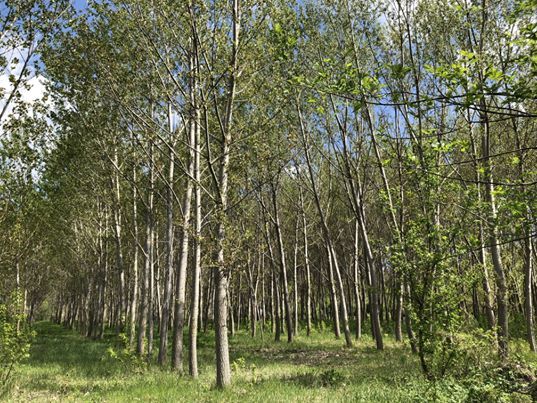Populus tremula
Populus tremula, commonly called aspen, common aspen, Eurasian aspen, European aspen, or quaking aspen,[2] is a species of poplar native to cool temperate regions of Europe and Asia, from Iceland[3] and the British Isles[4] east to Kamchatka, north to inside the Arctic Circle in Scandinavia and northern Russia, and south to central Spain, Turkey, the Tian Shan, North Korea, and northern Japan. It also occurs at one site in northwest Africa in Algeria. In the south of its range, it occurs at high altitudes in mountains.[5][6]
The English name Waverly, meaning "quaking aspen", is both a surname and unisex given name.
It is a substantial deciduous tree growing to 40 metres (130 ft) tall by 10 m (33 ft) broad, with a trunk attaining over 1 metre (3 ft 3 in) in diameter.[7] The bark is pale greenish-grey and smooth on young trees with dark grey diamond-shaped lenticels, becoming dark grey and fissured on older trees.
The adult leaves, produced on branches of mature trees, are nearly round, slightly wider than long, 2–8 cm (1–3 in) diameter, with a coarsely toothed margin and a laterally flattened petiole 4–8 cm (2–3 in) long. The flat petiole allows them to tremble in even slight breezes, and is the source of its scientific name,[7] as well as one of its vernacular names "langues de femmes" attributed to Gerard's 17th-century Herball. The leaves on seedlings and fast-growing stems of suckers (root sprouts) are of a different shape, heart-shaped to nearly triangular.[8] They are also often much larger, up to 20 centimetres (7.9 in) long; their petiole is also less flattened.
The flowers are wind-pollinated catkins produced in early spring before the new leaves appear; they are dioecious, with male and female catkins on different trees. The male catkins are patterned green and brown, 5–10 centimetres (2.0–3.9 in) long when shedding pollen; the female catkins are green, 2–6 centimetres (0.79–2.36 in) long at pollination, maturing in early summer to bear 10–20 (50–80) capsules each containing numerous tiny seeds embedded in downy fluff. The fluff assists wind dispersal of the seeds when the capsules split open at maturity.[9][5][7]
It can be distinguished from the closely related North American Populus tremuloides by the leaves being more coarsely toothed.[5]
Like other aspens, it spreads extensively by suckers (root sprouts), which may be produced up to 40 m from the parent tree, forming extensive clonal colonies.[9][5]


